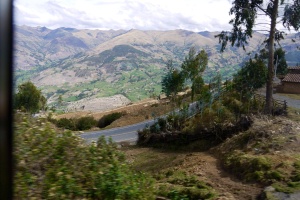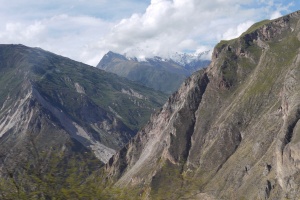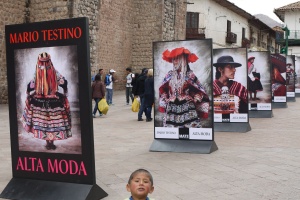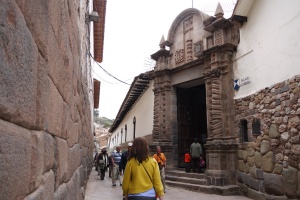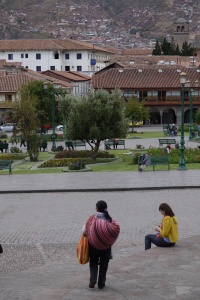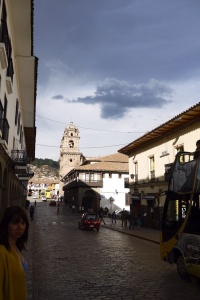Arriving into Cusco from Abancay involved yet another long bus ride. Thankfully this time it was only 5 hours, all in day light and supported by some very good travel sickness pills we had quickly purchased after the last dreadful bus trip. However, the road to Cusco is not like the one to Abancay. The road is broader, smoother and in far better repair. Taking a cheaper local bus rather then the 5 star Cruz del Sur also provided greater interaction with the locals. We stopped more than once to pick up ‘hitch-hikers’ moving between towns all of whom I am guessing were charged a few soles for their fare. Some of these jumped on board to sell their wears – food, drink and a few random gadgets. Our favourite was the ‘choklo’ girl who must have been caught a little by surprise by the bus as her and her girlfriend were still boiling the huge white corn cobs and taking the finished ones from the pan. These we’re then placed in a plastic bucket lined with a traditional, brightly woven blanket to keep them warm to sell on the bus. These girls moved fast to make sure one of them made the bus with the steaming maize.

A ‘choklo’ with crumbly white cheese set us back just 2 soles and we should have bought two! The texture of the steamed maize on the cob is both soft and chewy and the addition of the almost feta like cheese added a nice sharp tang: in a word delicious. This would not be our last choklo snack.
The bus meandered through the incredible hills and valleys further up into the Andes. Each corner showing off glimpses of the glorious snow capped Salkantay in the distance. The fields outside changed from corn to flowers to fruit trees (papaya, oranges, avocados) to prickly pear every few kilometres. Aqueducts and road side drains efficiently redirect the ice melt from the mountains down into the valleys and fields below making for lush detailed land. It seemed that the Peruvians could grow anything in the vast number of micro climates created by the conversion of the Andes to the east, the tropics to the north and the Pacific Ocean along the west coast. This was an assumption that was quickly confirmed by our first visit to the market in Cusco – a vegetarians delight if ever there was one (well at least in one half of the market, the other side could be considered a carnivores delight). Each house we passed had it’s own mix of chickens, pigs, sheep, cows, horses, donkeys and of course dogs. In the greener parts of the hills the number of baby sheep and pigs was high, indicating fertility was certainly not restricted to the fields. Eucalyptus trees, imported in the late 1800’s to provide quick growing, strong timber for railway tracks, covered many of the hillsides. It was obvious where logging had occurred as the original tree stumps now sprouted three to four new tricks all growing out at various angles. It struck me that Peruvian children were growing up with the same familiar smells and smooth, grey barked tree trunks that we had in Gippsland. The smell from the chimneys through the hills was just like home too only here it was quickly mixed with diesel fumes from the passing trucks and buses.
The creation of mud bricks seemed to be the other main industry throughout the hills. Each small village had at least a few areas set up for their production, small piles covered with a piece of corregated tin or a plastic bag with rocks on top to keep the rain off. Some houses out of the villages were making their own. Often you could see a pile of bricks in the various stages of creation and drying lying to one side of what must have been someone’s very slowly evolving house. One wonders how long it must take to build a whole home…
Our bus driver was also an interesting fellow. Clearly confident in his job security, he stopped for a pee on the side of the bus (some times it pays not to be a ‘chismosa’ looking out the bus window). And not long after this he stopped again to talk to a mate in a ute for at least 5 minutes in the middle of the main highway. I’m sure the conversation would have continued if it was not the arrival of other traffic waiting to continue their journey.

As we approached the towns on the fringes of Cusco we began to notice a pair of terracotta bulls together with a Christian cross on the roof tops of many houses. We later discovered that these were good luck charms that were thought to bring prosperity and wealth through fruitful harvests and healthy crops. These charms mark the introduction of beasts of burden by the Spanish in the 1500s and also their enforced Catholicism on the Pachamama worshiping Quechua.
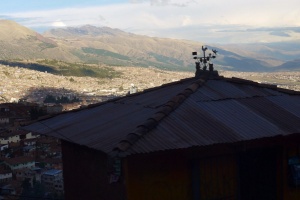
As we turned the last corner into the heights of upper Cusco we realised that it was perhaps not the traditional Inca that were to be the icons of this town, for that sugary,sweet, almost fluorescent-yellow drink of Inca Kola was billed and advertised on every available space. The multi-national Coca-Cola bought out a hefty share of the local soft drink company back in 1999, a smart move as Inca K dominated the market far out selling Coke in Peru. Later we discovered another local trademark was also partially in foreign hands – Peru Rail. British Rail are one of a number of operators that have leasing arrangements with Peru Rail including trains that run out to Macchu Pichu and south to Puno, including the five star Hiram Bingham Orient Express. One look at the prices and it’s clear that like us, the locals are catching the bus!

Korean monks in the main plaza. We had a brief chat with one of them and discovered that it was a pilgrimage of sorts that they were on to various religiously significant places. Still don’t understand the face masks. However, they didn’t seem to be sucking on oxygen bottles like quite a few of the Japanese tourists we came across. I guess if you haven’t brought Diamox with you and don’t want to chew on coca leaves the OxyShot canisters are viable option – but still hilarious!
Mario Testino photo bomber – this kid was on to it. Picked his moment to pop up into the frame as I took the shot.
CK checking out the ‘Palacio de la Justicia’ (Palace of Justice)

Local ladies in the street
The beautiful Palacio Arzobispal built on the foundations of Inca stone work.
A close up of some of the amazing hand carved Inca stones that are the foundation of the most magnificent colonial buildings in Cusco. We discovered on one of our tours that many of the stones were rediscovered after a major earthquake in the 1980’s that caused the stucco that was covering them to fall off. It must have been a great annoyance to the Spanish that every time there was an earthquake their buildings would suffer huge damage whilst all of the Inca stones remained perfectly in place. I hope they regretted what they destroyed.
One of the seemingly endless number of street cleaners who work hard to keep the streets of Cusco spotless.
Rainy streets of Cusco. Thankfully the mornings were usually fine and sunny allowing lots of time to wander and explore. Come mid afternoon you needed to make sure you were either close enough to your hotel to make a run for it or you had packed a full body poncho. No umbrella is going to save you from this rain.
Save the animals! One of the walls along the main plaza seems to be dedicated to local protests and announcements. For a few days it was covered with posters made by school children. Some were quite impressive, others grousome and straight to the point.
To be continued…
Stay tuned for food, CK in suspenders, post modern bulls and lots more.


